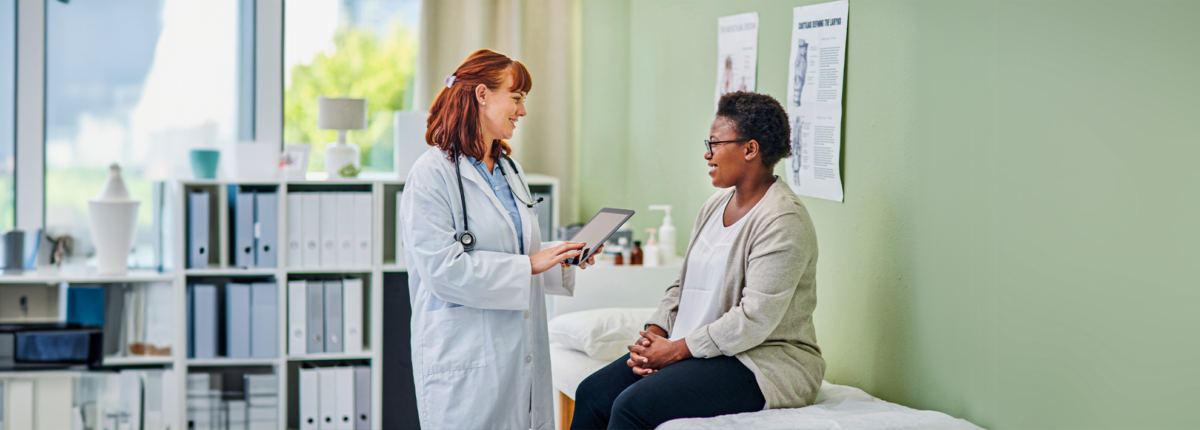Disparities in Diabetes and Diabetes Care—What Can We Do About It?
Written by: Lala Jackson
6 minute read
June 16, 2020
In an American Diabetes Association (ADA) Scientific Sessions panel addressing disparities in diabetes and care, five researchers were asked: what disparities exist and what can be done about it?
Researchers shared learnings from their work with specific populations across the country, focused on strategies to address disparities. Across their research, systemic racism and implicit bias were clear contributors to poor health and healthcare outcomes for Black and Latinx communities. Below, we jump into the highlights of the session.
Examining disproportionate social risks and their impact on health outcomes
Dr. Ashley M. Butler (Texas Children’s Hospital/Baylor College of Medicine) shared her work examining disproportionate social risks for Black and Latinx youth with type 1 diabetes and their families. Her work has found that, right from the point of diagnosis, minority youth experience elevated blood sugar levels that persist throughout life. This is particularly true for Black and Latinx children diagnosed before the age of nine, so she advocates for early, tailored interventions.
Dr. Butler’s work explores the many risks that disproportionately impact minority families, including food insecurity, financial insecurity, more severe levels of unemployment, inflexible work environments, increased barriers to care in school environments and more. As we know, many of these issues are tied to long-standing systemic racism, and each creates makes it more difficult to manage diabetes.
Dr. Butler shared powerful qualitative patient perspectives about specific barriers faced by a disproportionate number of Black and Latinx families:
- “I can’t have my phone on me due to my restrictive work environment, so if my child has a health issue at school, the school can’t call my cell.”
- “I don’t have the ability to keep enough food in the house to maintain blood sugar levels.”
- “I’ve heard about 504 plans and keep hearing my child has a right to one, but the administrators at my child’s school avoid any conversations to put one in place.”
To address these issues and more, Dr. Butler has spent a significant amount of time exploring effective interventions. They include:
- Tailored community outreach. This includes ensuring inclusive language and images are used in marketing materials and literature and culturally tailoring diabetes events and camps so they do not just cater to one audience.
- Asking questions around social needs and listening to those answers, so that families can be linked to tailored resources that directly address their expressed needs.
- Creating social and behavioral support resources, specifically catering to families who have limited time.
Integrating Youth Feedback to Address Disparities for Young Adults
Dr. Shivani Agarwal (Albert Einstein College of Medicine) shared strategies she and her team have learned to better support Black, Latinx and low socioeconomic status young adults. Dr. Agarwal’s work is centered in New York City.
Young adulthood is an extremely vulnerable time for anyone with diabetes. Navigating multiple life transitions that impact financial stability, access to healthcare, social support and more can throw care into disarray. In addition, young adults are the largest growing diabetes population in the United States and BIPOC (Black, Indiginous and other People of Color) are diagnosed with diabetes, especially type 2, at rates higher than others.
Dr. Agarwal’s work shows that Black and Latinx youth in particular face higher levels of financial instability, lower health literacy and carry the burden of unaddressed adverse childhood events. Black youth self-reported issues of food and financial insecurity, as well as mistrust in healthcare providers. Latinx youth self-reported difficulty in navigating expectations of multi-generational families, lack of attention paid to their culture by healthcare providers and language barriers around complex health terms. This then translates to higher HbA1c levels for both populations. Specifically, Black youth experienced higher diabetes distress, lower involvement in self management, and an average 2.26% higher HbA1c.
Near the end of her presentation Dr. Agarwal addressed the pervasive underlying issues in her work. She made it clear that healthcare providers often don’t have insight into other communities, cultures and the historical contexts that impact care, so they need to ensure they are taking the time to learn from colleagues across cultures. This includes thinking about how to tailor healthcare approaches and communication strategies.
At every step in their programs for young adults, Dr. Agarwal and her team have included young adults on their consulting boards, ensuring they are building programs that are best for the populations they are trying to serve.
When asked about disparities, Dr. Agarwal mentioned that data shows these disparities for Black and Latinx young adults are pervasive globally and only going to widen. She also mentioned that there is an implicit bias from healthcare providers who believe that racial and ethnic minorities cannot handle being put on diabetes technology. She called on her colleagues to address this issue.
Addressing diabetes disparities in the Latinx communities of Chicago
Dr. Arshiya Baig (University of Chicago) examines diabetes disparities within Latinx communities in Chicago, Illinois. Major barriers to health and healthcare for this population include economic barriers, lack of access to safe spaces to exercise, lack of access to health insurance and issues around perceived safety in pursuing healthcare. As a result, only one third of the Latinx population achieve optimal glycemic control.
To address disparities, Dr. Baig and her team created community-based interventions, informed by church-based Community Advisory Boards (CABs). Together, they created educational curriculum and patient navigation resources for Latinx communities in Chicago.
Dr. Baig’s team also worked with healthcare providers on how to better serve the community and address cultural barriers within health centers. CABs helped to create cultural-competency training for healthcare providers in clinics. Community involvement in creating these resources was key to their success.
Healthcare providers reported higher cultural awareness, more awareness of personal biases and barriers and increased knowledge on helpful resources for Latinx communities. Community members reported more healthful eating, increased connection to community and increased awareness of resources.
Acknowledging how intensely the Latinx community has been hit by COVID-19, Dr. Baig also shared learnings from this unique health event. Disparities are rampant, with only one in six Latinx workers able to work from home, and the Latinx community experiencing higher healthcare disparities, higher poverty levels and more crowded living situations, each leading to poorer health outcomes amidst COVID-19.
So what is needed to address health/healthcare disparities, both for COVID-19 and diabetes?
- Address underlying health disparities
- Create culturally and linguistically tailored messaging
- Address valid fear of accessing healthcare and public resources
- Train teams of community health workers
- Advocate for workplace protections for workers
- Provide culturally tailored emotional support
At the end of Dr. Baig’s session, she was asked to explain what changes are needed in the healthcare system overall. She responded that healthcare must be culturally tailored, that language and culture are important and that trust must be built and cultivated.
What we learned
Health and healthcare disparities in diabetes are a result of systemic racism, implicit bias and socioeconomic barriers to healthcare access. Research and continued studies from this field can help create strategic means to address these issues, but only if learnings are applied.
The full live-tweet thread from the session can be found here.
Click here for complete coverage of ADA 2020 from Beyond Type 1.

Author
Lala Jackson
Lala is a communications strategist who has lived with type 1 diabetes since 1997. She worked across med-tech, business incubation, library tech and wellness before landing in the type 1 diabetes (T1D) non-profit space in 2016. A bit of a nomad, she grew up primarily bouncing between Hawaii and Washington state and graduated from the University of Miami. You can usually find her reading, preferably on a beach.
Related Resources

Already compatible with Dexcom’s G6 and G7 continuous glucose monitors (CGMs), the Omnipod 5 Automated...
Read more

The younger a person is diagnosed with type 2 diabetes, especially those with obesity, the...
Read more

The Oura Ring, which tracks things like sleep, heart rate, and activity, is joining forces...
Read more

